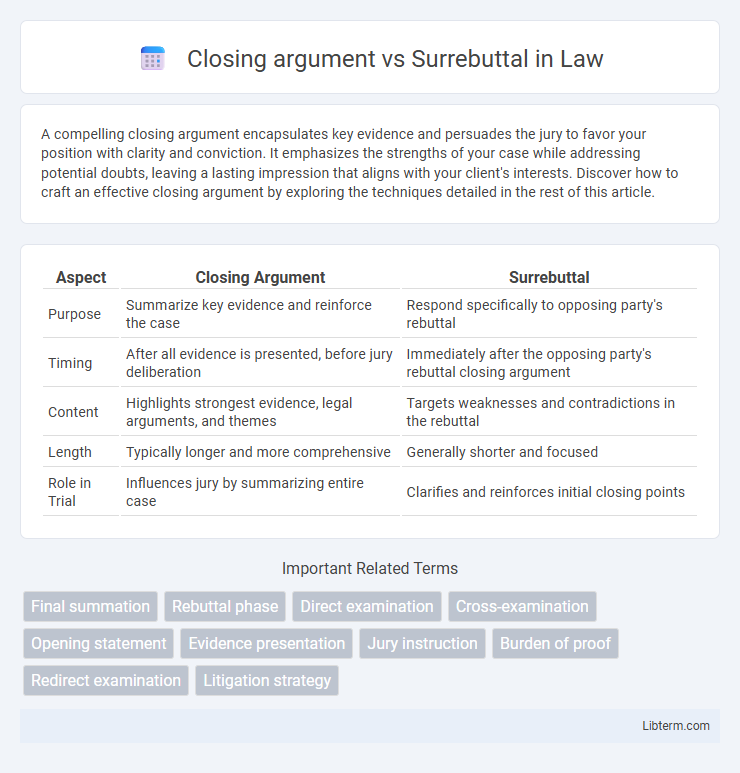A compelling closing argument encapsulates key evidence and persuades the jury to favor your position with clarity and conviction. It emphasizes the strengths of your case while addressing potential doubts, leaving a lasting impression that aligns with your client's interests. Discover how to craft an effective closing argument by exploring the techniques detailed in the rest of this article.
Table of Comparison
| Aspect | Closing Argument | Surrebuttal |
|---|---|---|
| Purpose | Summarize key evidence and reinforce the case | Respond specifically to opposing party's rebuttal |
| Timing | After all evidence is presented, before jury deliberation | Immediately after the opposing party's rebuttal closing argument |
| Content | Highlights strongest evidence, legal arguments, and themes | Targets weaknesses and contradictions in the rebuttal |
| Length | Typically longer and more comprehensive | Generally shorter and focused |
| Role in Trial | Influences jury by summarizing entire case | Clarifies and reinforces initial closing points |
Understanding Closing Arguments
Closing arguments summarize the key evidence and themes presented during a trial to persuade the jury toward a favorable verdict. Unlike surrebuttals, which specifically respond to new points raised in rebuttal arguments, closing arguments provide a comprehensive final appeal without introducing new evidence. Understanding closing arguments is essential for grasping how attorneys synthesize testimony and facts to reinforce their case strategy effectively.
Defining Surrebuttal in Legal Context
Surrebuttal in a legal context is a party's response to the opposing party's rebuttal evidence or arguments, introduced to counter new points that were not addressed during the initial rebuttal phase. Unlike closing arguments, which summarize the case and persuade the judge or jury, surrebuttal is limited to addressing specific issues raised in the rebuttal to ensure a fair and balanced presentation of evidence. This targeted response helps maintain the integrity of the adversarial process by allowing parties to clarify or challenge new evidence without reopening the entire case.
Purpose of a Closing Argument
The purpose of a closing argument is to summarize the evidence presented during the trial, reinforce key points, and persuade the jury to render a verdict favorable to the presenting party. Unlike a surrebuttal, which responds directly to new evidence introduced during rebuttal testimony, the closing argument offers a comprehensive narrative that emphasizes the strengths of the case and the weaknesses of the opposition. Effective closing arguments strategically highlight witness credibility, factual evidence, and legal standards to shape the jury's final decision.
Role and Timing of Surrebuttal
The closing argument serves as the final summary of a party's case, emphasizing key evidence and legal points to persuade the judge or jury. The surrebuttal occurs after the rebuttal, providing the plaintiff or prosecution an opportunity to address new issues raised, clarifying or reinforcing their position before the trial concludes. Its timing allows the responding party to counter unexpected arguments, ensuring a balanced and fair presentation of evidence.
Key Differences Between Closing Argument and Surrebuttal
Closing argument summarizes the evidence and key points presented during the trial, aiming to persuade the jury or judge towards a favorable verdict. Surrebuttal occurs after the rebuttal phase, allowing the plaintiff or prosecution to respond to new evidence or arguments introduced during the rebuttal. The key difference lies in timing and purpose: closing arguments conclude the trial by reinforcing the overall case, while surrebuttals address specific points raised late in the hearing to prevent unfair advantage.
Strategic Importance in Trial Proceedings
Closing arguments serve as the final opportunity for attorneys to summarize evidence and reinforce their case narrative, emphasizing critical facts and legal standards to persuade the jury. Surrebuttals allow the opposing party to address new issues raised during rebuttal, ensuring no unexpected evidence goes unchallenged and preserving the right to a fair trial. Both play strategically vital roles: closing arguments consolidate the case's impact, while surrebuttals maintain evidentiary balance and prevent one-sided conclusions.
Impact on Jury Perception
Closing arguments consolidate evidence and legal reasoning, shaping the jury's final understanding and reinforcing the attorney's narrative. Surrebuttals provide an opportunity to directly address and counter opposing counsel's new points, thereby mitigating potential damage and clarifying misunderstandings. The impact on jury perception hinges on the ability of each phase to effectively persuade and solidify key case themes in the jurors' minds.
Challenges in Delivering Effective Closing Arguments
Closing arguments demand persuasive synthesis of evidence and law to solidify juror conviction, yet they face challenges such as maintaining clarity while addressing complex legal points. Surrebuttals complicate this task by introducing last-minute counterarguments that require quick adaptation and strategic refocusing of the narrative. Effective delivery hinges on balancing emotional appeal with logical coherence under time constraints, ensuring the jury retains the case's key messages.
Effective Techniques for Surrebuttal
Surrebuttal is a critical phase in trial advocacy where the defense responds directly to the plaintiff's rebuttal, aiming to reinforce their case and address new issues raised. Effective techniques for surrebuttal include concise, targeted refutation of opposing evidence, use of clarifying testimony to dispel misconceptions, and strategic reinforcement of key arguments to solidify jury perception. Mastering surrebuttal enhances a lawyer's ability to control the narrative, counter surprises, and preserve credibility before closing arguments.
Conclusion: Maximizing Final Impressions in Court
Closing arguments serve as the final opportunity for attorneys to summarize evidence and persuade the jury by reinforcing key themes and legal standards, creating a compelling narrative to maximize impact. Surrebuttals offer a brief chance to address new issues raised during rebuttal, ensuring no critical points are left unchallenged before concluding. Effective use of both stages sharpens the clarity of arguments, strengthening the attorney's position and leaving a lasting, persuasive impression on the court.
Closing argument Infographic

 libterm.com
libterm.com